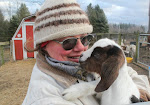 |
| Just-dug deliciousness! |
This unusual seasonal tuber is actually a perennial member of the sunflower genus which has towering stalks that grow as high as ten feet tall with a cluster of daisy-like brilliant yellow flowers at the apex of each stalk.
 |
| The patch towering over the trellis and outhouse. |
While some producers choose to harvest as soon as the flowers begin dying back, I have always waited for Mother Nature to choose my harvest date--after the first killing frost of the season. That frost was yesterday meaning that this afternoon I was out digging in the dirt so I'd have fresh chokes for farmers markets tomorrow.
As always, everyone asks, "How do you use them?" "What do they taste like?"
You can:
- Eat them raw
- Boil & mash them with a little butter
- Saute them
- Bake/roast them
- Steam them
- Deep fry them (and absolute delight as we found out at Cafe Bruges a few years ago after having unsold product when I stopped in for a post-market libation.)
Often mistaken for ginger root, the knobby tubers are a good source of carbohydrates. The sun choke stores inulin instead of insulin as its starch for extra energy during winter months. This can be useful, especially for people who limit glucose in their diets, because the inulin breaks down into fructose rather than glucose during digestion. This unique quality can make the tuber a good substitute for other starchy foods like potatoes, particularly for diabetics and Paleo eaters.
An unpleasant side effect for some people, the "fartichokes" tend to cause intestinal gas due to the fructose.
These vitamin-rich roots are high in thiamin, niacin, and iron. They also contain relatively large amounts of potassium and Vitamin C, while being low in calories. The tubers contain no fat or cholesterol, and only small amounts of sodium. A 1 cup serving of sun chokes contains approximately 110 calories, 3 grams of protein, and 2.4 grams of dietary fiber.
Ready to give them a try? Here are some serving suggestions and recipes.
Roasted Sun Chokes and other fall vegetables
6 cups assorted fall root vegetables (winter squash, parsnips, turnips, beets, carrots, sun chokes, brussel sprouts, cauliflower, etc.)
1 large onion
1 bulb garlic
1/4 cup olive oil or nut oil
Sea salt & freshly ground black pepper
Clean and chop all vegetables into 1-2" pieces. Peel garlic cloves. Place all vegetables into an airtight container, add oil and thoroughly coat. Spread on baking sheet and season with salt & pepper. Roast in oven pre-heated to 400 degrees until cooked through and caramelized (20 - 30 minutes). Enjoy!
Sandra’s Sun Choke Gratin
Ingredients:
1 quart box of Painted Hand Farm Sun Chokes
4 tablespoons butter
1/2 cup freshly grated artisan cheese (I’m preferential to a drier sheep cheese, but any great local cheese will do. Support farmstead creameries!)
1/4 cup cream
Salt & Pepper
Instructions:
Preheat oven to 400 degrees F.
Using one tablespoon of butter, smear oven-proof dish.
Scrub and slice sun chokes. Arrange in a single layer in dish, sprinkle with cheese, add another single layer, sprinkle with cheese and continue until dish is full or chokes are gone. Season top layer, drizzle with cream, dot with remaining butter and sprinkle with cheese. Bake until soft, golden and bubbly. Let rest ten minutes before serving.
 |
| Sun Chokes at sunset |































